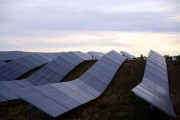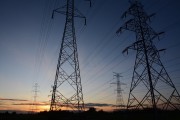There’s a common misconception that increasing the supply of renewable energy to the electricity grid drives up power costs in Alberta. It’s a myth perpetuated by those advocating for fossil fuel-powered electricity generation, despite the high social and environmental costs of those fuels.
In fact, clean energy is lowering Albertans’ electricity costs.
Both solar and wind energy are subsidizing our electricity rates in different ways, as new data analysis from the Pembina Institute shows. Understanding why that happens requires a closer look at how the electricity market works.
In Alberta, the price that energy producers receive for supplying power to the grid is set on an hourly basis. Prices during the day — when solar power is being produced — are typically higher than at night. As such, small-scale solar photovoltaic producers are generating some of the most valuable energy in the market.
But these producers — like homeowners with solar panels on their roofs — receive a fixed price for the electricity they feed into the grid. That price is consistently 30 to 40 per cent lower than daytime prices in the energy market. In other words, small-scale solar producers are selling their energy at a discount.
Wind energy, meanwhile, is a utility-scale energy source. Wind power producers receive the market price that is set every hour. Alberta’s energy market buys power from a mix of sources that are available to meet demand at any given time. Because wind power has no fuel costs, it’s the lowest-priced source available whenever the wind blows. Wind is therefore one of the first sources to be used to meet demand.
That cheap wind power, when it’s available, brings down the overall market price that other producers are paid. As a result, the windiest days are the cheapest days to buy (or sell) electricity. By reducing the market price precisely when they’re selling energy into the market, wind energy producers receive the lowest price for their energy: They were paid 28 per cent less than producers of coal power, on average, in 2013.
In these ways, both solar and wind energy generators are paid a discounted price for the electricity they supply to the grid. That lowers Albertans’ electricity costs, but it comes with a downside.
Because of these discounts, there is less incentive for companies or individual Albertans to invest in clean electricity sources. Although Alberta has some of the best wind and solar resources in the country, we don’t capitalize on them to the extent that we should. That means less fuel-free energy for consumers.
Instead, Alberta’s current policy is locking us into relying heavily on natural gas for our electricity. That’s risky on two scores.
First, while it’s better than coal, natural gas generation still emits plenty of carbon pollution. With the limited opportunity we have to avoid the worst climate disruptions, we can’t afford to lock ourselves into new gas plants that will still be operating past 2050.
Second, natural gas prices have proven to be volatile. Gas is cheap now, but prices will rise. If they climb more quickly than expected, it would significantly increase electricity costs for Albertans.
Theoretically, the market should find and favour the lowest-cost energy producer. In reality, the market’s direct impact is to incent generators to invest in the highest-profit energy source.
This encourages investors to pick new natural gas generation. They can be reasonably certain that they’ll secure a good return on investment, since natural gas plants increasingly set the market price. If gas prices go up, so will electricity prices. That’s good for generators — but not so good for consumers, who will end up paying more for their power.
That helps to explain the price modelling in the Pembina Institute’s recent Power to Change report, released with Clean Energy Canada. It showed that, with more clean energy sources like wind and solar in our electricity mix, prices would rise less quickly in the long run.
Implementing the policies we need to increase the mix of renewable energy supplied to our grid would have two benefits: It would level the playing field for wind or solar producers, allowing them to compete in the market on the basis of demand and innovation, and it would put Albertans on track to pay less, over the long term, for energy that is clean, stable and sustainable.







